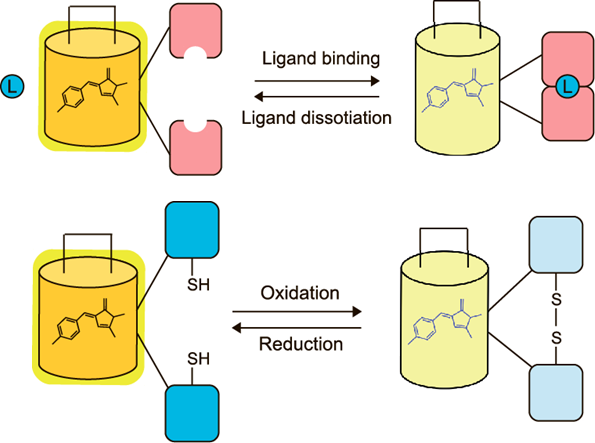Группа метаболических основ патологии
|
Отдел метаболизма и редокс-биологии Руководитель: Билан Дмитрий Сергеевич |
Группа образовалась в 2018 году.
Коллектив группы занимается разработкой генетически кодируемых биосенсоров для регистрации динамики различных биологических процессов в живых системах в режиме реального времени. Подобного рода инструменты приобрели широкую популярность для решения различных задач в биологии и медицине. Такой биосенсор представляет собой белковую молекулу, которая, как правило, состоит из двух функциональных частей: сенсорной и флуоресцентной. В качестве флуоресцентного домена используют флуоресцентные белки. В качестве сенсорной части биосенсора чаще всего используют природные домены белков, выполняющих различные функции в клетках. Принцип функционирования подобного биосенсора основан на том, что при воздействии определенного стимула, например, при специфичном связывании лиганда, сенсорный домен претерпевает конформационные изменения, которые передаются на флуоресцентный белок в составе конструкции, что вызывает изменения спектральных характеристик. Таким образом, динамика изменения флуоресцентного сигнала в заданной системе отражает динамику изменения исследуемого биологического параметра.

Данный подход визуализации биологических процессов становится неотъемлемой частью современных исследований. Такие методы универсальны и применимы для использования в самых разных биологических объектах. С использованием флуоресцентных биосенсоров коллектив научной группы занимается исследованием физиологических и патологических процессов на моделях in vivo.
В настоящее время в группе ведутся работы по in vivo исследованиям на грызунах динамики внутриклеточных процессов в тканях головного мозга при развитии ишемического инсульта. Еще одним модельным объектом в исследованиях группы является рыба zebrafish D. rerio. На данном объекте коллектив занимается изучением воспалительных процессов, вызванных различными факторами.
- разработка биосенсоров для регистрации гипогалогенных кислот и их производных;
- разработка биосенсоров для исследования метаболизма жирных кислот;
- разработка биосенсоров для регистрации сероводорода Н2S;
- исследование ключевых параметров клеток мозга на ранних стадиях развития ишемического инсульта;
- исследование окислительно-восстановительных процессов в тканях при воспалительных реакциях.
| ФИО | Должность | Контакты |
|---|---|---|
| Билан Дмитрий Сергеевич, д.б.н. | в.н.с. | |
| Иваненко А.В. | м.н.с. | |
| Катруха Вероника Алексеевна | м.н.с. | |
| Кокова (Демидович) А.Д. | м.н.с. | |
| Костюк Александр Игоревич, к.б.н. | м.н.с. | |
| Чебаненко Виктория Валерьевна | м.н.с. | |
| Васильев А.В. | тех.-лаб. | |
| Васильева Крестина Витальевна | тех.-лаб. | |
| Сергеева А.Д. | м.н.с. | |
| Судоплатов М.А. | тех.-лаб. | |
| Сухинина Софья Евгеньевна | тех.-лаб. | |
| Тятьков М.Г. | тех.-лаб. | |
| Наумов Л.Л. | инж.-иссл. | |
| Хлыстова М.А. | м.н.с. | |
| Храмова Ю.В. | с.н.с. |
 Загрузка...
Загрузка...Научные проекты
 Загрузка...
Загрузка...Билан Дмитрий Сергеевич
Москва, ул. Миклухо-Маклая, 16/10 — На карте
 Загрузка...
Загрузка...
